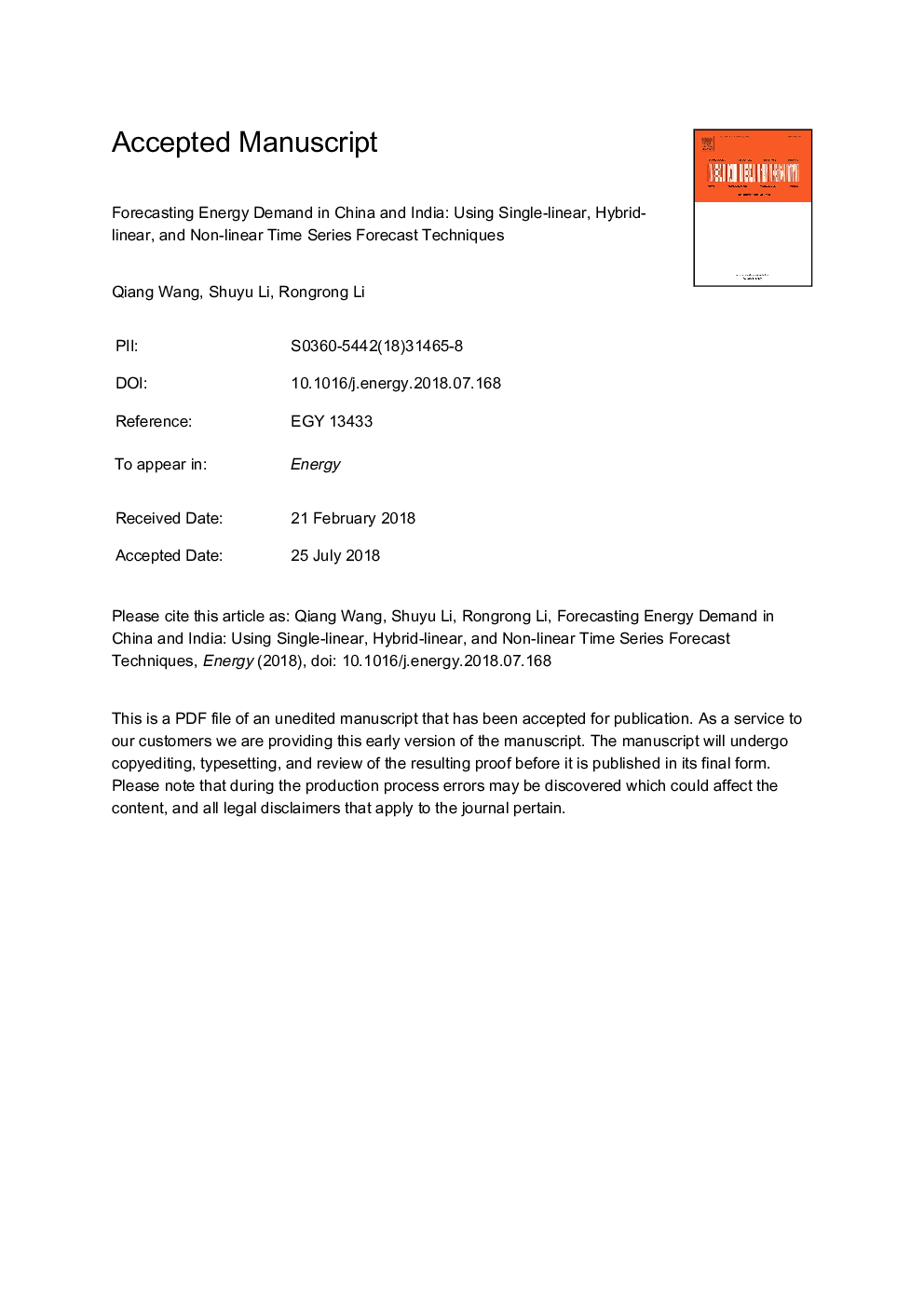| کد مقاله | کد نشریه | سال انتشار | مقاله انگلیسی | نسخه تمام متن |
|---|---|---|---|---|
| 8070890 | 1521389 | 2018 | 48 صفحه PDF | دانلود رایگان |
عنوان انگلیسی مقاله ISI
Forecasting energy demand in China and India: Using single-linear, hybrid-linear, and non-linear time series forecast techniques
ترجمه فارسی عنوان
پیش بینی تقاضای انرژی در چین و هند: با استفاده از تکنیک های پیش بینی خطی تک خطی، ترکیبی خطی و غیر خطی
دانلود مقاله + سفارش ترجمه
دانلود مقاله ISI انگلیسی
رایگان برای ایرانیان
کلمات کلیدی
چین و هند، مدل خطی و غیر خطی ترکیبی، پیش بینی، امنیت انرژی،
ترجمه چکیده
پیش بینی تقاضای انرژی در چین و هند می تواند به این کشورها کمک کند تا با چالش های آینده ناشی از تغییرات در این تقاضا، و نیز اطلاع رسانی نیازهای انرژی جهانی آینده را تامین کنند. در این مطالعه، تکنیک های تک خطی، ترکیبی خطی و غیر خطی مبتنی بر تئوری خاکستری برای پیش بینی دقیق تر تقاضای انرژی در چین و هند طراحی شده است. این تکنیکهای پروسه برای شبیه سازی مصرف انرژی چین و هند در سالهای 1990 تا 2016 به کار رفته است. سه استاندارد (نقشه روند، اندازه گیری خطا و روش مناسب) برای تجزیه و تحلیل کیفیت روش پیش بینی برای اندازه گیری کیفیت این روش پیشنهادی استفاده می شود . نتایج نشان می دهد که این تکنیک های پیشنهادی دارای سطح بالایی از انطباق، نرخ خطای کم و دقت بالا هستند. به عنوان مثال، میانگین خطای مطلق درصد خطوط تک خطی، ترکیبی خطی و غیر خطی به ترتیب 1.30-3.08٪، 57.2٪ -80.5٪ و 2.06-2.19٪ است. نتایج حاصل از تجزیه و تحلیل بهینه نشان می دهد این مدل های پیشنهادی می توانند نتایج پیش بینی قابل اعتماد در چین و هند تولید کنند که ممکن است برای پیش بینی تقاضای انرژی در سایر کشورها / مناطق استفاده شود. نتایج پیش بینی ما نشان می دهد نرخ رشد سالانه تقاضای انرژی هند از سال 2017 تا سال 2026 برابر با 4.49٪ -51.21٪ (تک خطی)، 2.42٪ -7.04٪ (ترکیبی خطی)، 0.58٪ -4.02٪ (غیر خطی) ، به ترتیب. نرخ رشد سالانه تقاضای انرژی چین از سال 2017 تا سال 2026 به ترتیب 1.36٪ -1.70٪ (تک خطی)، 1.04٪ -1.49٪ (خط ترکیبی)، 1.80٪ -2.34٪ (غیر خطی) است. انتظار می رود نرخ رشد مصرف انرژی هند 2-4 برابر چین از سال 2017 تا 2026 باشد، که نشان می دهد هند در بازار انرژی جهانی حتی مهم تر خواهد شد.
موضوعات مرتبط
مهندسی و علوم پایه
مهندسی انرژی
انرژی (عمومی)
چکیده انگلیسی
Better forecasting energy demand in China and India can help those countries meet future challenges caused by the changes in that demand, as well as inform future global energy needs. In this study, the single-linear, hybrid-linear, and non-linear forecasting techniques based on grey theory are developed to more accurately forecasting energy demand in China and India. These prosed techniques were applied to simulate China's and India's energy consumption of China and India between 1990 and 2016. Three standards (trend map, error measure, and fit method) of analyzing quality of forecast technique are used to quantify the quality of these proposed technique. The results show these proposed techniques have a very high degree of fit, a low error rate, and high fitting precision. For example, the mean absolute percent error of single-linear, hybrid-linear, and non-linear techniques are 1.30-3.08%, 0.80-2.57%, and 2.06-2.19%, respectively. The results of optimality analysis show these proposed models can produce reliable forecasting results in China and India, which might be used to forecasting energy demand in other countries/regions. Our forecasting results show the annual growth rate of India's energy demand from 2017 to 2026 will be 4.49%-5.21% (single-linear), 2.42%-7.04% (hybrid-linear), 0.58%-4.02% (non-linear), respectively. The annual growth rate of China's energy demand from 2017 to 2026 will be 1.36%-1.70% (single-linear), 1.04%-1.49% (hybrid-linear), 1.80%-2.34% (non-linear), respectively. The growth rate of India's energy consumption is expected to be 2-4 times that of China from 2017 to 2026, indicating India will become even more important in the global energy market.
ناشر
Database: Elsevier - ScienceDirect (ساینس دایرکت)
Journal: Energy - Volume 161, 15 October 2018, Pages 821-831
Journal: Energy - Volume 161, 15 October 2018, Pages 821-831
نویسندگان
Qiang Wang, Shuyu Li, Rongrong Li,
